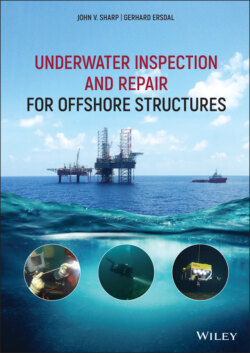Читать книгу Underwater Inspection and Repair for Offshore Structures - Gerhard Ersdal - Страница 41
2.5.4 NORSOK N‐005—Concrete Structures
ОглавлениеNORSOK N‐005 (Standard Norge 2017b) has a special annexe covering inspection of concrete structures. This standard makes the point that concrete structures are normally damage tolerant because of their large dimensions and planning of inspections should take this into account. However, it also points out that ageing concrete structures in air may experience increasing amount of chloride ingress that may lead to corrosion of reinforcement in areas of poor‐quality concrete.
Specific requirements for data collection and management relating to concrete structures include:
operational criteria for caisson cells operated with differential hydrostatic pressure (drawdown) or normal hydrostatic pressure in cells;
operational criteria for cells used for oil storage and/or water ballast;
any reported repairs or discontinuities in the concrete from the fabrication phase. Specifically, repair of reported leakages in the concrete;
description of mechanical systems for operating the ballast water, oil filling and draw down systems in the storage cells; and
settlement and tilt monitoring.
Regarding evaluation of changes NORSOK N‐005 (Standard Norge 2017b) states that the following items are noted for concrete structures:
the condition of the concrete surface. Particularly the concrete surface above seawater level, due to weather exposure and chloride penetration, including core testing or dust samples of the concrete;
condition of coatings and linings, if present;
the cathodic protection of the concrete reinforcement; and
monitoring of crack development in highly utilized areas (e.g. near topside footings/bearings).
NORSOK N‐005 (Standard Norge 2017b) notes that the probability of failure of concrete structures is most often related to corrosion and less to fatigue damage. In addition, failure below the waterline is minimised by the presence of anodes providing corrosion protection to the steel reinforcement. As a result, large areas of a concrete structure such as caisson walls and shaft walls below water have relatively low probability and consequence of failure. Hence it is considered that a lower level of inspection for these structural components may influence the level and content of the inspection programme.
NORSOK N‐005 (Standard Norge 2017b) states that special attention should be given to areas of major importance for the structural integrity and for the atmospheric and splash zones, particularly where the risk of deterioration is highest. Areas of major importance are listed as complex connections such as wall‐dome connections, cell wall joints, columns to caisson connections and load bearing areas in the top of shafts. Construction joints, penetrations and embedments should also be considered.
NORSOK N‐005 (Standard Norge 2017b) notes that for inspection planning the potential failure mechanisms listed below should be taken into consideration. These can lead to typical types of failure, which include reinforcement corrosion, cracking, spalling and delamination and damaged coatings and abrasion:
construction‐related imperfections;
cracks due to formwork adhesion;
lack of reinforcement cover;
lack of concrete compaction;
unplanned construction joints;
chloride ingress;
corrosion of reinforcement behind cast‐in plates;
subsidence and seabed scouring;
internal defects in conjunction with oil storage such as leakage and biological activity;
leakage;
impact damage; and
freeze/thaw damage and ice abrasion.
In executing inspection of concrete structures NORSOK N‐005 (Standard Norge 2017b) states that programmes should be developed after the DFI resume has been delivered and updated periodically. A general statement is made that inspection planning should focus on verification of the condition of the structural components so that structural integrity can be maintained. It also states that taking into account the likely types of defects and damage which may develop, appropriate inspection methods should be developed. An example is given indicating that because delamination is often not visible on the concrete surface, hammer tapping may be needed to detect such areas.
NORSOK N‐005 (Standard Norge 2017b) notes that corrective maintenance should be implemented to prevent minor damage escalating into major damage. It is important to maintain steel reinforcements and pre‐tensioning to ensure structural functionality during the lifetime of the structure.
